By Flint Whitlock
The U.S. Army’s 10th Mountain Division served its country, then returned home to build our favorite industry
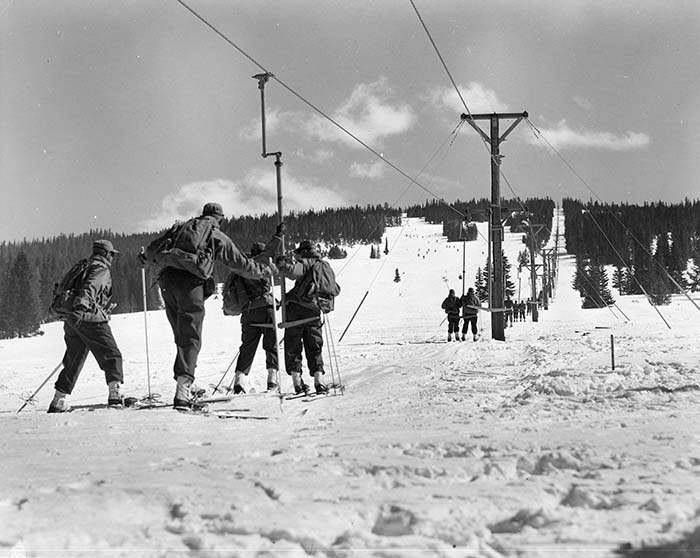
SOLDIERS RIDE THE T-BAR TO THE TOP OF 12,714-FOOT CHICAGO RIDGE AT COOPER HILL. AFTER THE WAR,
THE AREA BECAME SKI COOPER, A FAMILY-FRIENDLY SKI AREA.
IF YOU’RE A COLORADO SKIER OR SNOWBOARDER, you are following in the tracks made by heroes of World War II—men who volunteered to fight for their country 80 years ago and came back from war-torn Italy to kick-start the American ski industry. These men were part of the original 10th Mountain Division—founded by Charles Minot “Minnie” Dole, head of the National Ski Patrol System.
In the late 1930s and early 1940s, Dole watched the war spread across Europe—especially into the cold, mountainous regions of Finland and Norway—prompting him to write to Gen. George C. Marshall, U.S. Army chief-of-staff. He proposed creating divisions of soldiers specially trained for mountain and
winter warfare.
Initially disinterested, Marshall finally authorized Dole to begin recruiting for what would eventually become the 10th Mountain Division. Camp Hale, a permanent training camp, was built in record time—April to November 1942—high in a remote Colorado valley along U.S. Highway 24 between Minturn
and Leadville.
Joining the mountain troops was like applying to an exclusive club or fraternity. Before admission, volunteers had to provide three letters of recommendation attesting to their outstanding character and athletic abilities.
Some of the finest skiers and mountaineers in the world filled the division—hundreds of whom had escaped from Europe before Hitler took over their homelands. There were also many American men who had raced for their schools and colleges (mainly Ivy League). Probably the most well-known member was Norwegian Torger Tokle, holder of the world’s record in the ski jump at that time.
During the winter, the rigorous training included skiing from morning until night, with some treks going from Camp Hale to Aspen. In the summer, they climbed mountains and went on 25-mile hikes. And they participated in survival training year-round. It was tough, but most of the soldiers loved it.
But there was a problem. After more than a year of training, most soldiers worried they would never see combat. The U.S. Army had no idea what to do with this highly specialized unit of 14,000 brash, hot-shot skiers and climbers—and their 4,000 pack mules and horses. Even after American ground troops first tangled with Italian and German units in North Africa in November 1942, followed by clashes in Sicily, Italy and France, the Army had no combat assignment for the 10th.

SERGEANT TORGER TOKLE, A NORWEGIAN, WAS THE HOLDER OF THE WORLD’S RECORD
IN THE SKI JUMP AND ONE OF THE MOST FAMOUS MEN IN THE 10TH. HE WAS KILLED IN ITALY IN MARCH 1945.
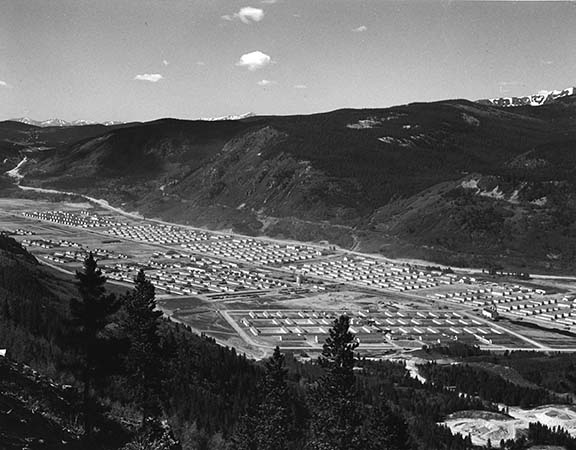
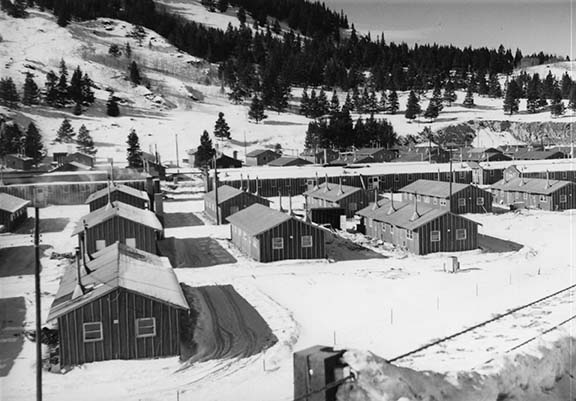
ONCE COMPLETED, CAMP HALE, HOME TO MORE THAN 14,000 PERSONNEL AND THE HIGHEST MILITARY POST IN THE U.S., FILLS THE PANDO VALLEY WITH NEARLY 1,000 WHITE-PAINTED BUILDINGS.
A PORTION OF THE PANDO CONSTRUCTORS’ CAMP WHERE 10,000 WORKMEN LIVED WHILE BUILDING CAMP HALE.

A 240-WOMAN WOMEN’S ARMY CORPS DETACHMENT WAS STATIONED AT CAMP HALE AND PERFORMED ADMINISTRATIVE DUTIES AT THE POST.
OFF TO WAR
It wasn’t until late 1944, with the Allies stalled in the rugged northern Apennine Mountains of Italy, that Lt. Gen. Mark Clark learned about the availability of the 10th and requested they be immediately shipped across the Atlantic. They were the last American division sent overseas.
Once the 10th’s soldiers arrived in the mountains north of Pisa and Florence, they were ordered to break through the Germans’ defensive line across Italy, which had stymied Allied efforts to reach the Po River Valley.
Determining that a terrain feature known as Riva Ridge was the linchpin in the enemy’s defenses in this front sector, the officers of the 10th devised an audacious plan. They would climb the steep, “unclimbable” southern face of the ridge in the dead of night, with no preliminary artillery bombardment that would alert the enemy of the coming attack.
A battalion of about 1,000 men climbed throughout the night of February 18, 1945. At dawn, they reached the crest of the ridge and surprised the Germans in their foxholes. Despite several counterattacks, the battalion stood firm, breaking the enemy’s hold on this vital ridge. The following day, the rest of the division attacked nearby Monte Belvedere and, after nearly a week of fighting, evicted the German defenders. The way into the Po Valley was now open.
When one is successful in battle, the reward is usually more battle. Lt. Gen. Clark had the 10th spearhead what was called a “limited offensive” in March 1945—an offensive that cost ski-jumper Torger Tokle
his life.
In April, the 10th was again chosen to spearhead Operation Craftsman—the Allies’ final push in Italy to reach the Alps. During this savage fight, 2nd Lt. Bob Dole, who would be the 1996 Republican presidential candidate, was severely wounded. Hundreds of other 10th men lost their lives.
But the breakthrough was successful. The 10th was the first American unit across the Po River and the first to reach Lake Garda, Italy’s largest lake. It was there, on May 2, when the war in Italy ended. The 10th’s short time in combat cost them 1,000 dead and 4,000 wounded.

PHOTO: COURTESY WILLIAM BROWN FAMILY)
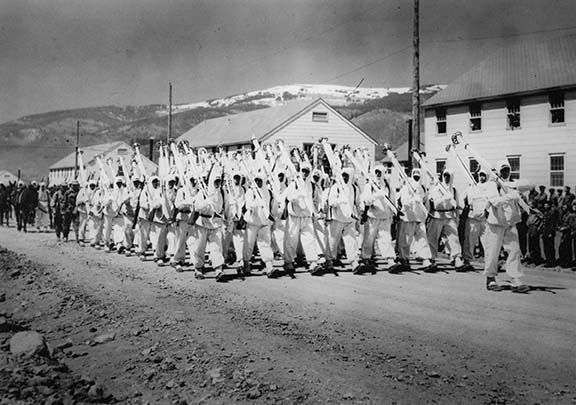
PHOTO: COURTESY DENVER PUBLIC LIBRARY
WITH A DOG LEADING THEM, A PLATOON OF MOUNTAIN TROOPERS IN WHITES AND CARRYING SKIS MARCHES PAST A REVIEWING STAND AT CAMP HALE. THE TROOPS OFTEN SANG WHILE THEY MARCHED.
A PLATOON OF WHITE-CLAD SKI TROOPERS, FOLLOWED BY MULES, PARADES DOWN A CAMP HALE STREET.
A POSTWAR WORLD
After the war, many of the 10th’s veterans returned to devote their lives to promoting and developing the sport of skiing. In Colorado, Vail, Aspen and Arapahoe Basin were the brainchildren of 10th Mountain Division veterans. Steamboat, Loveland Basin and Winter Park had 10th veterans at the helm of many aspects of their operations. Across the U.S., it was virtually impossible to find a ski area that didn’t have at least one 10th veteran involved in some aspect of its operation.
If you’ve skied Vail (opened in 1962), you’ve probably taken a few runs on “Minnie’s Mile,” named for “Minnie” Dole, and “Riva Ridge,” named after the division’s first major battle.
And if you decide to hit the slopes at Ski Cooper, you’ll be skiing the same runs that the troops used as their advanced ski-training hill—then known as Cooper Hill. A memorial to the 10th’s soldiers killed in action stands on Highway 24 at the entrance to Ski Cooper. And the Colorado Snowsports Museum in Vail has an excellent permanent exhibit devoted to the 10th.
It’s safe to say that no other American military unit impacted civilian life like the 10th Mountain Division did. Colorado Ski Country USA’s website says, “The 10th Mountain Division was one of the most important catalysts for the spread of skiing into an affordable, enjoyable pastime of middle-class America.”
Some veterans reflected on their accomplishments. “I hate to brag,” says Hugh Evans of Boulder, a past president of the Tenth Mountain Division Foundation and a 2016 inductee into the Colorado Snowsports Hall of Fame. “But had it not been for us, skiing in America would be very different. Aspen might still be a little ghost town with a few ski runs, and Vail probably would never have been built.”
Chris Anthony, a Colorado native, professional extreme ski racer, filmmaker and Colorado Snowsports Hall of Fame inductee, has created several documentaries about the 10th Mountain Division, including his latest, “Mission: Mount Mangart.” He said, “The accomplishment of the 10th, along with the stories that follow the legend, have not only been inspirational for me as a skier but also built the foundation for where I get to experience the sport. I cannot imagine where the American ski industry would be today without their impact.”
The courageous men of the 10th Mountain Division lived their lives by the division’s motto: Sempre
Avanti—Always Forward!
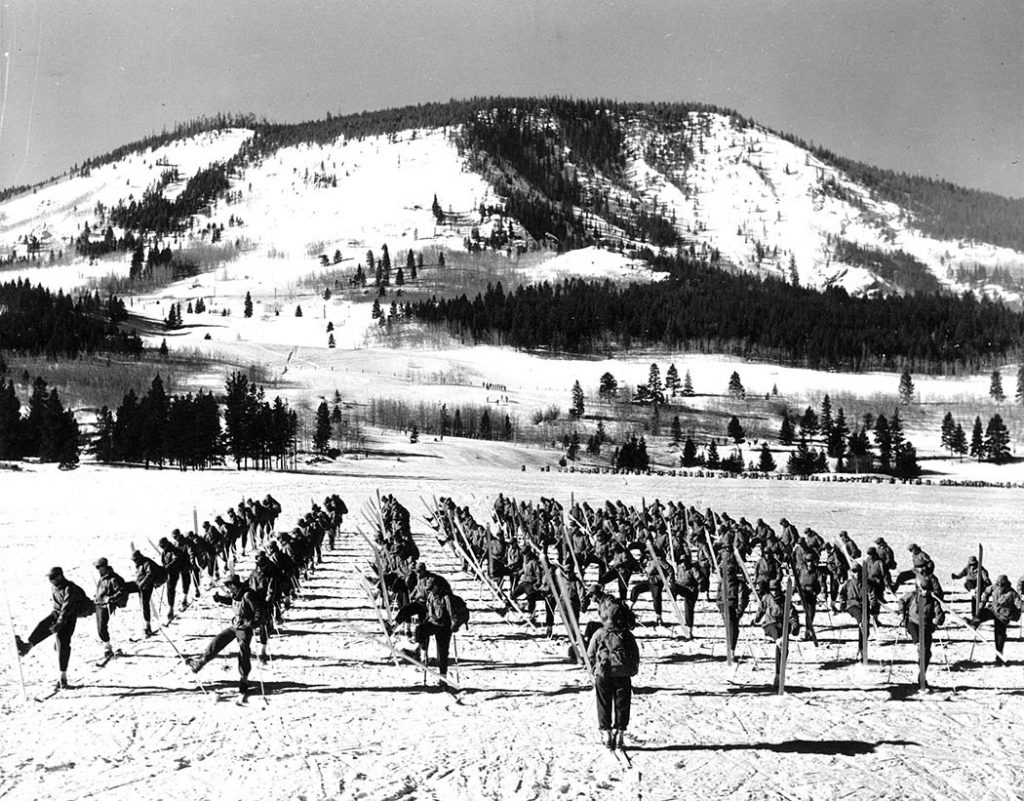
SOLDIERS PRACTICE A KICK-TURN MANEUVER. MANY SOLDIERS WERE DRAFTEES WHO HAD NEVER BEEN ON SKIS BEFORE AND HAD TO LEARN THE BASICS.
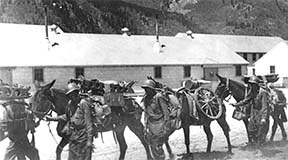
PHOTO: COURTESY DENVER PUBLIC LIBRARY
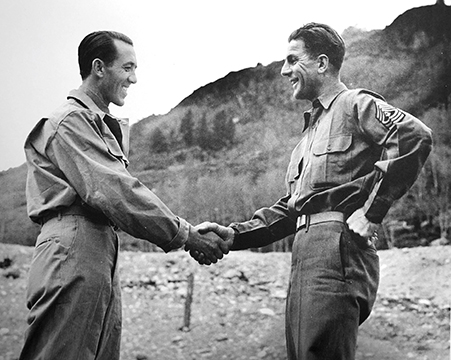
PHOTO: COURTESY DENVER PUBLIC LIBRARY
MEN OF AN ARTILLERY BATTALION LEAD A MULE TEAM WITH THE COMPONENTS OF A 75MM PACK HOWITZER STRAPPED TO THEIR BACKS. MULES WERE ESSENTIAL IN CARRYING SUPPLIES INTO THE BACK COUNTRY WHERE FEW ROADS EXISTED.
WALTER PRAGER (RIGHT), A SWISS AND THE FORMER DARTMOUTH COLLEGE SKI-TEAM COACH, WELCOMES AUSTRIAN CHAMPION SKI RACER FRIEDL PFEIFER TO CAMP HALE. AFTER THE WAR, PFEIFER WOULD BE ONE OF THE 10TH VETERANS WHO STARTED THE ASPEN SKI RESORT.
Flint Whitlock is the son of a 10th Mountain veteran, the co-author of “Soldiers on Skis,” editor of WWII Quarterly magazine and a 2021 inductee into the Colorado Authors Hall of Fame.


